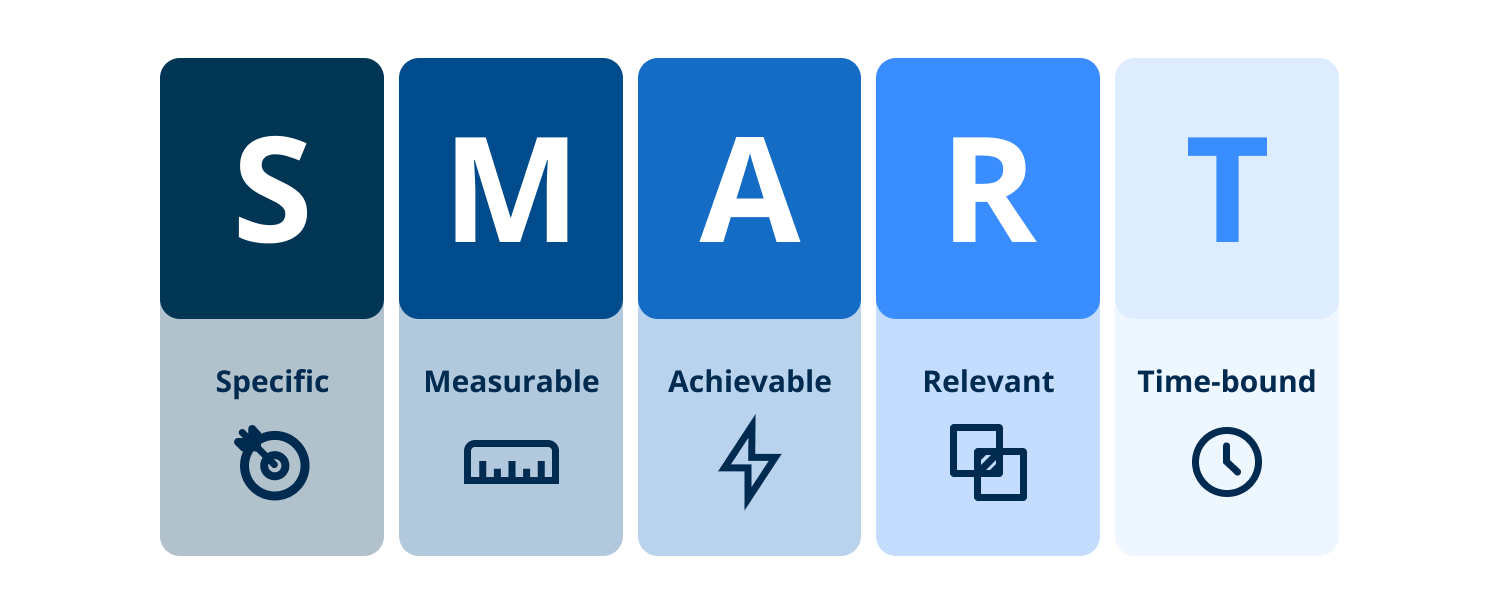SMART financial goals: Things to consider
What you need to know about tracking and setting SMART financial goals.
SMART goal setting: Using the SMART money goals framework can help you set clear, structured, and actionable financial goals.
Monitor your goals: Break larger SMART financial goals into manageable steps, track your progress, and adjust as needed.
Avoid common pitfalls: When setting SMART financial goals, avoiding common mistakes such as unrealistic expectations, lack of planning, and failure to align goals with your budget can help you better reach your goals.
What are SMART financial goals?
SMART financial goals are a tested method for setting clear, attainable objectives that help you stay focused and organized when managing your finances. The SMART acronym stands for Specific, Measurable, Achievable, Relevant, and Time-bound. Using this framework of setting SMART financial goals can guide your decision-making process, provide structure, and increase your chances of success.

Each element of the SMART money goals helps you learn more about managing your savings efficiently. This is how they might apply to your personal financial progress:
S – Specific: The goal should be well-defined and clear. A vague goal like “I want to save money” is less effective than “I want to save $6,000 for a down payment for a car.” Being specific helps you visualize the goal and outline the steps to reach it.
M – Measurable: You need a way to quantify and measure your goal. Tracking your savings or debt payments can help you measure progress. For example, “Save $200 per month” or “Pay off $1,000 in credit card debt by making $100 payments each month.”
A – Achievable: Consider whether your SMART financial goal is realistic based on your income, expenses, and financial situation. Overly ambitious goals can lead to frustration, so you might want to start with small, achievable wins and build momentum.
R – Relevant: Your financial goal should align with your current life stage, values, and broader objectives. Whether it is saving for retirement, creating an emergency fund, or reducing (credit card) debt, the goal should support your long-term financial wellbeing.
- T – Time-bound: Set a clear deadline to complete the goal. A time frame creates urgency and accountability. For instance, “Save $3,000 for a vacation in nine months” provides a specific target date to work toward.
How to set SMART financial goals
By setting SMART financial goals, you are actively designing a roadmap helping you reach your goals, because you are learning how to achieve the progress you desire. SMART financial goals start with understanding where you are now, learning where you want to go, and creating a clear, realistic plan to get there.
Before you can set effective SMART money goals, take time to review your current financial situation. This means looking at your income, expenses, outstanding debts, and savings. Knowing your numbers — how much you earn, spend, and owe — can provide a good starting point for responsible goal-setting.
Once you understand your financial baseline, you may want to shift your focus to learning more about your priorities and useful strategies for achieving them. Examples of SMART financial goals vary widely depending on your life stage, family structure, values, and personal desires. It is often helpful to break SMART financial goals down into three categories: short-term, mid-term, and long-term goals.
Once your goals are broadly outlined, you can go through each one and ask yourself:
Is it specific enough to take daily, weekly, or monthly action toward?
Can I measure my progress over time?
Is it realistic based on my current income, expenses, savings, and obligations?
Does it reflect something that matters to me personally or professionally?
Have I set a deadline or timeframe to complete it?
SMART financial goals: Examples
Listing your SMART money goals allows you to visualize your financial priorities and clarify what progress looks like. However, simply naming your goals is not enough. The real power comes from turning these intentions into SMART financial goals.
Examples of SMART financial goals have to be specific and actionable. Goals like “save more money” or “get out of credit card debt” are too vague to guide your daily actions. On the other hand, saying “Save $5,000 for a vacation over 10 months by setting aside $500 each month” gives you a clear target, timeline, and plan for action.
SMART financial objectives: Examples
Timeframe: | Duration: | Examples: |
Short-term | 0–1 year | Paying off high-interest credit card debt to reduce stress and increase cash flow, saving for a wedding, vacation, or emergency fund |
Mid-term | 1–5 years | Building a down payment for a home, purchasing a new car, starting a business or preparing for a major life change (e.g., relocation) |
Long-term | 5+ years | Contributing regularly to a retirement fund (e.g., 401(k), IRA), creating a college fund for your child, becoming financially independent or paying off a mortgage early |
Here is another great example of a SMART financial goal that meets all five criteria: "Save $1,200 for a new laptop in six months by setting aside $200 per month from my paycheck."
Specific: The goal is clear — save for a new laptop.
Measurable: The total amount and monthly contributions are defined.
Achievable: Based on the person’s income, saving $200 per month is realistic.
Relevant: The goal aligns with a current need or desire.
Time-bound: There is a six-month deadline, creating a sense of urgency.
This is a classic textbook example of how to turn a vague intention into a well-structured, SMART financial goal. By applying the same approach to your own priorities — whether it is savings, budgeting, or debt reduction — you will probably see progress in a short amount of time.
Tips to achieve your SMART money goals
Once your SMART financial goals are set, the next step is making steady progress. Here are some strategies to help make it easier to stay on track:
Start a savings account
Savings accounts are a great way to help keep you accountable when it comes to reaching your SMART goals. Savings accounts can also help diversify your savings, and options like high-yield savings accounts can help you reach your financial goals even faster.
The Raisin marketplace gives you access to high-yield savings options with competitive interest rates, to help you smash your savings goals. Explore different savings options and start reaching your goals today!
Financial goal chart
Visualizing your progress with a financial goal chart can be incredibly motivating and rewarding. These charts allow you to see where you started, how far you have come, and how much further you need to go to reach your goal. Whether you use a digital app, a spreadsheet, or a printed goal tracker, the visual representation can help make your efforts feel more tangible.
Break goals into smaller pieces
Large SMART money goals can feel overwhelming, which can make it harder to take the first step. Breaking them into smaller, manageable pieces makes them more achievable and less stressful. This approach helps make progress feel more attainable and encourages you to stay consistent with your efforts.
Stay accountable
Accountability is a powerful motivator when it comes to reaching your SMART financial goals. Sharing your goals with a trusted friend, family member, or financial advisor can increase your commitment and follow-through. You can also set personal reminders or use budgeting apps that send notifications and track your actions.
Celebrate your success
Celebrating milestones along the way helps maintain motivation and reinforces positive habits. Whether you have reached a small benchmark or reached your SMART money goal, recognition matters. Choose rewards that are meaningful but budget-friendly, like a special meal or a fun outing.
Common mistakes to avoid
Even after setting SMART financial goals, it can be easy to go off course. Life can be unpredictable, and without a thoughtful approach, financial goals can become forgotten or feel unachievable.
Setting unrealistic goals
Ambition is great, but setting SMART financial goals that far exceed your financial capacity can lead to burnout and discouragement. While your SMART money goals should challenge you, they must also be realistic based on your actual financial situation. Focus on attainable milestones that can help you stick to your savings resolutions.
Not having a plan
Identifying a SMART financial goal is an important start, but it is only part of the equation. Without a clear, structured plan of action, even the most well-defined goals can stagnate. It can help to break down each goal into small, achievable steps and setting deadlines. Being time-bound allows you to remain focused and to measure consistent progress.
Disregarding your budget
You might be excited to fund a vacation or build a home down payment, but if your current budget does not support regular contributions, the SMART money goal may quickly fall apart. Are you wondering how to budget money efficiently? Make sure you account for all fixed and variable expenses when calculating how much you can realistically allocate each month.
Not tracking your progress
If you do not track your progress, it is easy to lose momentum or forget your original target altogether. Regular check-ins help ensure you are still on track to reach your financial goals. Tracking your progress also helps you spot patterns, like overspending or inconsistent saving habits, that might be interfering with your progress. Features like spreadsheets, budgeting apps, or visual charts can help you stay engaged.
Bottom line
If you are ready to take control of your financial future, setting SMART financial goals is a powerful first step. This framework helps you create clear, achievable objectives that fit your budget and priorities. Whether saving for a down payment, paying off debt, or funding retirement, SMART financial goals can help you stay motivated and on track.
To support your SMART money goals, the Raisin marketplace is here to help. Raisin gives you access to various high-yield savings products, to help make the most of your savings. Sign up today and start watching your savings grow.
Related Content
The above article is intended to provide generalized financial information designed to educate a broad segment of the public; it does not give personalized tax, investment, legal, or other business and professional advice. Before taking any action, you should always seek the assistance of a professional who knows your particular situation for advice on taxes, your investments, the law, or any other business and professional matters that affect you and/or your business.


